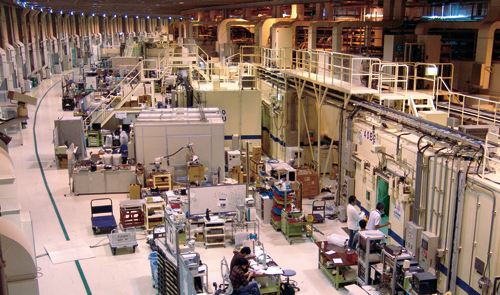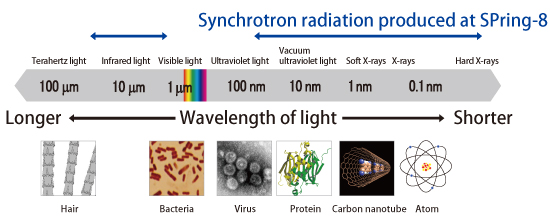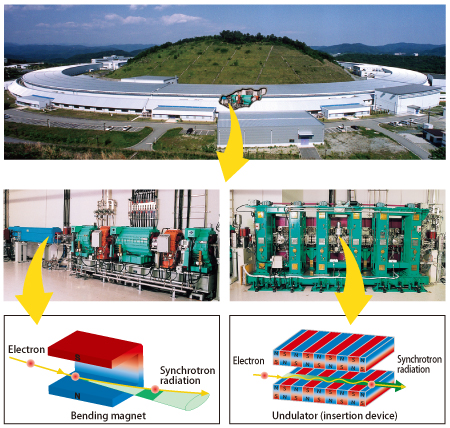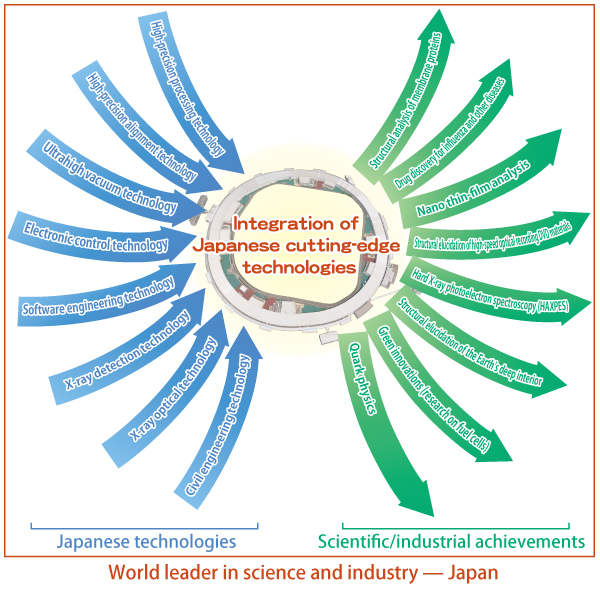What is SPring-8?
Many people believe the well-known proverb “seeing is believing”, indicating that humans obtain the majority of information through sight. You require light to see objects as your eyes perceive their images by the reflected light. Similarly, in science “seeing” is very important. Suppose you want to take a picture of a friend, lighting significantly impacts the photograph, and must be carefully selected based on the desired effect. Likewise in science, selecting the appropriate type of light to visualize an object is crucial. Thus, a facility that can produce many types of light is extremely beneficial.
SPring-8, one of the world's largest synchrotron radiation facilities, is “a science eye” to microscopically see natural phenomena. Below is an overview of how the microscopic world and large science facilities are connected as well as an explanation of the benefits from this connection.

Temperature-controlled experimental hall of the storage ring at SPring-8. Numerous scientific and technological advances have been realized here.

Observing objects with X-rays
Scientists have already revealed many governing laws and principles using visible light such as sunlight. Hence, intellectual curiosity has shifted to exploring the microscopic world. At SPring-8, we target the atomic and molecular worlds by investigating the properties of materials' electronic states. To reveal the vast world inside a material, including microscopic phenomena and structures, SPring-8 produces the world's most powerful X-rays with a high penetrating power. Hence, SPring-8 is like a “giant microscope.”
When observing an object with a light microscope, the field of view darkens as the magnification is increased because the amount of light illuminating the object's surface decreases as the observation area becomes smaller. Thus, to explore atomic and molecular worlds, well-collimated powerful X-rays, called synchrotron radiation, are necessary (Fig. 1). To realize highly directional powerful X-rays with a sufficient intensity to irradiate a small area, we constructed a large accelerator, called an electron storage ring at SPring-8.

Fig. 1. Details of an object can clearly be seen by illuminating with bright light (visible light in this case).
Revealing the microscopic world through large facilities
SPring-8 is located in Harima Science Garden City, western Hyogo Prefecture, Japan. It is comprised of a storage ring built in a large torus-shape building with a 1,436 m circumference.
When bunches of electrons (electron beams) circulate at nearly the speed of light in the storage ring, each electron in the beam emits X-rays (synchrotron radiation). Electromagnets are placed along the orbit to bend the direction of the electron's motion into a circular orbit, causing the electron beams to emit highly directional powerful X-rays called synchrotron radiation in the direction of the tangent to the circular orbit. At SPring-8, we utilize an accelerator (a storage ring) to produce synchrotron radiation by intentionally bending the direction of electron beams.
Synchrotron radiation has the following features:
• Extremely bright
• Highly directional and well collimated
• Broad wavelength range spanning infrared light to X-rays
• Polarized
• Pulsed light blinking with short intervals
Utilizing these features, we conduct diverse science experiments. Moreover, X-rays (synchrotron radiation) at SPring-8 have additional superior features; they possess extremely high energy and are bright. To obtain these high quality X-rays, we set the circumference of the storage ring to 1,436 m and accelerate electrons up to 8 GeV because higher energy electron beams produce higher energy X-rays. These higher energy X-rays, which are called hard X-rays, have very short wavelengths. The large circumference of the storage ring contributes to the better collimation of electron beams, resulting in highly collimated X-rays emitted from these electron beams. Such highly collimated X-rays can brightly irradiate a microscopically small area.
However, just being bright (possess a large number of photons) by itself is not enough. X-rays must also be well collimated without broadening, in other words, the X-rays must be highly “brilliant,” The large circumference of the storage ring enables undulators (insertion devices) to be placed along the electron beam's orbit. Our undulators are used to produce powerful synchrotron radiation (Fig. 2), which allows many extraction lines of synchrotron radiation (beamlines). This configuration effectively utilizes this valuable facility. Currently, we can simultaneously conduct experiments at up to 62 locations at SPring-8.

Fig. 2. Bending magnets and undulators (insertion devices), which can each produce synchrotron radiation, are situated in the storage ring.
Exploring with synchrotron radiation
What does synchrotron radiation reveal? Typically, when you observe an object sunlight hits it, and then the reflected light enters the lens of your eye to focus the object on the retina. However, X-rays are needed to reveal the microstructure of a material. X-rays emitted from a material irradiated with synchrotron radiation (X-rays) and the state of the material after irradiation provide information on the microstructure of the material.
Observations using X-rays can be divided into two major categories in terms of the underlying physical processes. The first category detects the resulting X-rays upon irradiating a material. X-rays have a high penetrating power and can enter deep into a material, which allows them to interact in various ways with the atoms and molecules and eventually exit with physical information about the material. For example, the resulting diffracted or scattered X-rays provide structural information specific to the material (Fig. 3a). The second category examines a material by physically stimulating it with X-rays. This method includes investigations of X-ray absorption of a material by varying the X-ray energy and analyzing secondary photons or electrons emitted from the material after X-ray irradiation (Fig. 3b). From a practical perspective, observations using X-ray can be divided into five methods.
(1) X-ray diffraction and scattering methods
Because X-rays are a type of light, they behave as a wave. Therefore, X-rays are diffracted (bent and broadened) if the formation of atoms/molecules and the wavelength of X-rays satisfy a particular condition (the Bragg condition) when X-rays are irradiated onto crystal-like materials. Examining the position and strength of diffracted X-rays provides information about the crystal structure. Employing small-angle X-ray scattering (SAXS), in which the scattering angles of the X-rays are extremely small, enables the crystal structure, the behavior of small particles (between 1 nm and 1 μm), and the nonuniform structure of a material to be elucidated.
(2) Imaging
Capturing X-ray transparent images and examining the differences in the material-dependent X-ray absorption rates can yield information about the internal structure of a material. Compared to conventional X-rays, synchrotron radiation, which is highly directional, provides images with a significantly higher resolution. Additionally, micro- or nano-beams, which are produced by further focusing highly directional X-rays, can yield X-ray computed tomography (CT) images of very small objects.
(3) X-ray absorption fine structure (XAFS) technique
Materials partially absorb irradiated X-rays. Varying the X-ray energy may significantly change the absorption rate at a specific energy. Because this change depends on the elements, the electronic states of a particular element and the alignment states of the surrounding atoms in a material can be determined by measuring the absorption rates at various energies.
(4) Photoelectron spectroscopy
Irradiating with vacuum ultraviolet light or soft X-rays causes a material to emit electrons (photoelectrons). Measuring the energy and angular distributions of the emitted photoelectrons via select X-ray energies can elucidate the electronic states on the surface or inside of materials as well as the chemical-bonding states.
(5) X-ray fluorescence analysis
Irradiating with X-rays causes the atoms within a material to emit fluorescent X-rays. Analyzing these fluorescent X-rays can reveal the species and elemental content because the energy of fluorescent X-rays depends on the element.

(a) Interactions with atoms and molecules diffract and scatter X-rays, and this diffraction and scattering information offers clues about the structure of a material. (b) Analyzing the X-ray absorption rates or the X-rays and electrons emitted from a material reveals information about the inside of a material.
Giant yet precise SPring-8
SPring-8 produces the world's highest quality X-rays. We believe this is due to the superior performances of various apparatuses and devices, including the accelerators, and because SPring-8 itself is an exact integration of precision machineries in which cutting-edge technologies are incorporated. High quality electron beams are indispensable to produce extremely brilliant X-rays. In fact, electron beams in the storage ring at SPring-8 have excellent quality. Each bunch of electron beams circulating in the storage ring at nearly the speed of light has a flat shape that measures 6 μm and 300 μm in the vertical and horizontal directions, respectively (μm = 10−6 m; the thickness of hair is 100 μm) and 4 mm long along the direction of the beam (these values are based on the standard deviation). Additionally, each bunch contains about 10 billion (1010) electrons with 8 GeV of uniform energy and is narrowly clumped to the utmost limit to fit in this tiny volume.
Electron beams circulate 200,000 times per second in the beam pipe, which is composed on an aluminum alloy and has an ellipse-shaped cross-section with a several cm bore. To prevent the electron beams from colliding with residual gases, air pressure in the beam pipe is maintained on the order of ten trillionth (10−13) atmospheres, which is the vacuum level equivalent to satellite orbits in outer space. Additionally, four types of electromagnets are installed to stably circulate electron beams in the storage ring; they include bending magnets to shape and control the electron orbit, dipole magnets to correct the electron orbit, quadrupole magnets to focus the beams, and sextupole magnets to correct energy fluctuations. Together they account for over 1,500 magnets. Each electromagnet weighs on the order of 10 kg to 100 kg. The production error of the magnetic field performance is less then 0.01% and the installation error of the center of each magnet is less than 10 μm relative to the circle.
The electron beams orbit near the speed of light in the storage ring with a circumference of 1,436 m. Their orbits are continuously surveyed by 300 beam position monitors installed along the entire circumference with a measurement error less than 1 μm. By applying this measurement precision, the 1,436 m circumference varies by 10 μm with two cycles a day due to the deformation of the Earth's surface by the tidal force of the moon. This variation is equivalent to being 5 mm off when determining the distance between Tokyo and Osaka (about 500 km). However, our technology is sensitive enough to identify this minute variation.
Although very precise, SPring-8 is a massive world-class research facility. To ensure an extremely high level of stability, SPring-8 was constructed on the rock bed of Mihara-Kuriyama in Nishi-harima, Hyogo by grinding the rock hill to exposure the rock bed. However, even with these efforts, the building where the accelerator is housed expands and contracts due to various reasons, including the effects of sunshine. To avoid such variations, a chassis in which the body of the accelerator and its accompanying equipment are securely placed is physically decoupled from the building. Moreover, preventive measures are taken against temperature and vibrational fluctuations induced by air conditioners and cooling water as these variations can affect performance and cause beam instabilities.
Special features and contrivances
SPring-8 has two injection accelerators that in combination accelerate electron beams to 8 GeV. Prior to being injected into the storage ring, the electron beams are initially accelerated to 1 GeV by a linear accelerator measuring 140 m in length. The beams are then accelerated to 8 GeV by a booster synchrotron with a 400 m circumference. Even with the ultrahigh vacuum of the storage ring, electron beams are gradually lost and their intensities diminish over time due to disturbances such as the collision of electrons within each electron bunch. Hence, the beams have a finite lifetime, and consequently the brightness of the X-rays decreases. Thus, the loss of the electron beams is compensated to provide a stable X-ray intensity by injecting electron beams whose amounts are equal to the lost beams. (This is called a “top-up operation.”) Both the booster synchrotron and that of the storage ring have energies of 8 GeV, which allows the full energy injection from the booster. If these two energies differed, we would have to first reduce the electron energy of the storage ring or dump all the beams in the storage ring before the injection and then accelerate the injected electron beams to 8 GeV in the storage ring, which would interrupt experiments during the injection period.
At SPring-8, extremely brilliant X-rays are produced over a vast wavelength range from soft (long wavelengths) to hard (short wavelengths). To achieve this, insertion devices (5 m in length) are installed on the electron beam orbit of the storage ring. Each insertion device is comprised of many permanent magnets (a few cm wide), which are placed above and below the electron orbit. As electrons pass through each insertion device, they undulate to produce powerful synchrotron radiation (Fig. 2). At SPring-8, we developed world-class technology to produce more powerful X-rays by placing arrays of permanent magnets in an ultrahigh vacuum and by narrowing the gap between the arrays to a few mm. This technology has significantly impacted the world. Additionally, SPring-8 is the only synchrotron radiation facility in the world to have a storage ring with four 25-m long straight sections where several insertion devices are serially installed to produce more powerful X-rays.
In conclusion, SPring-8 integrates numerous highly advanced technologies developed in Japan, such as high-precision processing technology, electronic control technology, civil engineering technology, measurement/monitoring technology, and ultrahigh vacuum technology. These technologies have led to many advances spanning basic science to industrial applications, clearly demonstrating that SPring-8 is a global leader in science and technology (Fig. 4).
This brochure highlights some of achievements realized at SPring-8.

Fig. 4. Japanese technologies that support SPring-8 and various research achievements produced from the integration of these technologies.